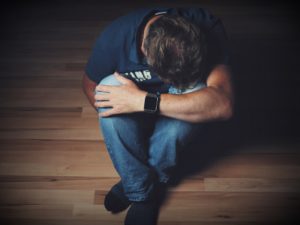- Calls to this hotline are currently being directed to Within Health or Eating Disorder Solutions
- Representatives are standing by 24/7 to help answer your questions
- All calls are confidential and HIPAA compliant
- There is no obligation or cost to call
- Eating Disorder Hope does not receive any commissions or fees dependent upon which provider you select
- Additional treatment providers are located on our directory or samhsa.gov
The LGBTQ Community and Eating Disorders

Contributor: Timberline Knolls Team at Timberline Knolls Residential Treatment Center
Among the reasons cited as to why individuals may develop eating disorders are concerns about body shape and weight, one’s idealization of being thin, and the social pressures that follow in that pursuit.
Also identified is a family history that encourages dietary restraint, disordered eating, values of perfectionism, and childhood teasing, negative affect, and impulsivity [1].
However, there are unique challenges that face those who belong to the LGBTQ community that may especially lead to the development of an eating disorder, as the prevalence of these disorders among the pride community is shocking.
In a study completed by The Trevor Project that surveyed LGBTQ youth, 54% had been diagnosed with an eating disorder, while another 21% suspected that they had an undiagnosed eating disorder [2]. In addition, according to the National Eating Disorder Association (NEDA), nearly half (42%) of all men who have eating disorders identify as gay [3].
These statistics reveal the unsettling reality that there appears to be a strong connection between one’s sexual and gender identity and the development of an eating disorder. However, a majority of research on eating disorders has been completed with cisgender and heterosexual individuals. This begs the question, what are the specific factors that may put this population more at risk?
In using EFT with clients who are suffering from eating disorders, three specific tasks are outlined to address:
Risk Factors for the LGBTQ Community
Coming out: From the very start of one’s understanding of themselves as a member of the LGBTQ community, a tension builds within them that often stems from fear of revealing the nature of their true identity and facing rejection. Whether real or imagined, experiences of rejection by friends, family, and other important figures in one’s life might propel them to internalize particular negative messages about themselves. These beliefs may lead to experiences of shame wrapped up in their identity, producing a diminished self-esteem and a negative effect known to trigger eating disorder symptomatology.
Body image ideals: Individuals in the LGBTQ community are not immune to the social pressures that face their cisgender and heterosexual peers. Among all demographics, lesbians were reported to have the greatest percentage of self-worth that was dependent upon weight, whereas gay men are more likely to experience body dissatisfaction, a drive for thinness, and body image anxiety. Even children as young as middle school age who identified as gay or bisexual were more likely than their peers to report the use of diet pills and other purging behaviors [1].
Experiences of violence/bullying: Statistics also point to the occurrence of increased bullying for members of the LGBTQ community in contrast to their peers, as 33% report being bullied on school property and another 27% report being bullied online (compared to 24% and 22%, respectively, among those outside the LGBTQ community) [4].
For the general population in this situation, instances of bullying not only cause a child to suffer academically, but they also increase the child’s risk of experiencing depression and suicidal ideation, engaging in risky sexual behavior, and misusing drugs and alcohol [4].
However, among the LGBTQ youth who were surveyed, 58% who were diagnosed with an eating disorder reported considering suicide, indicating this as a particularly dangerous cross-section of identity [2].
This is in addition to the possibility of developing posttraumatic stress disorder as a result of the chronic stress and acute trauma of bullying incidents, which research shows sharply increases vulnerability to an eating disorder [3]. Due to the high rate of comorbidity between eating disorders and other mental health conditions, it is important that individuals enter a treatment program that is trauma-informed and capable of providing treatment for co-occurring disorders.
Discrimination: Regarding discrimination, studies indicate that it makes no difference whether stigma toward someone is actual or perceived in its correlation with eating disorders, as some studies have even pointed to the fact that one’s perception of stigma against them is often a greater predictor of symptomatology [1].
These inadequate social interactions comprised of similar perceptions of discriminatory behavior lead to poor self-esteem and negative mood. These, in turn, appear to trigger specific eating disorder symptoms, such as restrictive eating and compulsive exercise, whose ploy is to increase self-esteem, and binge eating, which can be used to cope with negative emotions.
Lack of support: In addition to a lack of support from peers and school environments, many LGBTQ youths find themselves facing issues of homelessness or living in an unsafe home environment as a direct result of their sexual or gender identity. NEDA reported that up to 42% of homeless youth identify as part of the LGBTQ community, and one-third of children surveyed who were homeless or in the care of social services reported that they experienced violent assault when they came out [3].

More research is needed regarding these individuals; however, as they are susceptible to all of the above risk factors and more.
While there are many factors that appear to put a member of the LGBTQ community at risk for developing an eating disorder, it is also known that, conversely, having social support and a sense of connectedness to the gay community and cultivating the ability for self-compassion are protective factors.
These can all be enhanced in the life of someone who identifies as LGBTQ by learning to lean into kindness for and understanding of oneself (instead of judgment), participating in the larger human community (instead of self-isolating), and becoming an observer of one’s painful thoughts and feelings (rather than a reactor).
Sources:
[1] Bell, K., Rieger, E., & Hirsch, J. K. (2019). Eating Disorder Symptoms and Proneness in Gay Men, Lesbian Women, and Transgender and Non-conforming Adults: Comparative Levels and a Proposed Mediational Model. Frontiers in Psychology, 9. doi:10.3389/fpsyg.2018.02692
[2] Eating Disorders Among LGBTQ Youth: A 2018 National Assessment. (2018). Retrieved February 21, 2019, from https://www.thetrevorproject.org/wp-content/uploads/2018/03/Suicidality-and-Eating-Disorders-Among-LGBTQ-Youth-2018-2.pdf
[3] Eating Disorders in LGBTQ Populations. (2018, February 21). Retrieved February 21, 2019, from https://www.nationaleatingdisorders.org/learn/general-information/lgbtq
[4] LGBTQ Youth. (2017, September 24). Retrieved February 21, 2019, from https://www.stopbullying.gov/at-risk/groups/lgbt/index.html
About Our Sponsor:
At Timberline Knolls Residential Treatment Center outside of Chicago, Illinois, we provide specialized care for women and adolescent girls who are living with eating disorders.
The opinions and views of our guest contributors are shared to provide a broad perspective of eating disorders. These are not necessarily the views of Eating Disorder Hope but an effort to offer a discussion of various issues by different concerned individuals.
We at Eating Disorder Hope understand that eating disorders result from a combination of environmental and genetic factors. If you or a loved one are suffering from an eating disorder, please know that there is hope for you, and seek immediate professional help.
Published on February 27, 2019.
Reviewed & Approved on April 12, 2024, by Baxter Ekern, MBA
Published on EatingDisorderHope.com

